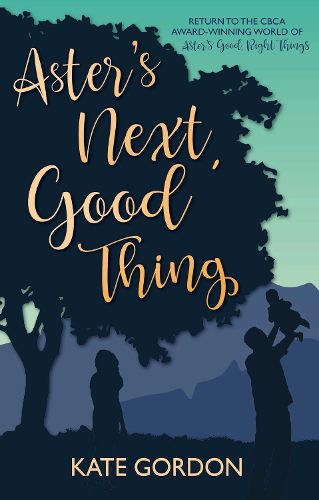Aster's next, good thing by Kate Gordon

A deceptively small book, easily read, with large sections being in a format akin to a free-verse novel with double line spacing, Kate Gordon's Aster's next, good thing packs a punch. The reader meets Aster again - the Aster of the CBCA Award-winning world of Aster's good right things. In Aster's good right things, Aster is performing a ritualistic pattern of behaviours which all started when her mother abandoned her. She believes that if she is faithful to performing one good right thing/day, everything will be alright. One year on, in the sequel, Aster's next good thing, Aster is not doing well at all. She believes that she is not important to anyone, that, if she floated away no-one would even notice. This is exacerbated when her Dad and his new partner Nella announce that Nella is pregnant and expecting a new baby. Aster has to cope with change.
Use of the free-verse structure creates an impactful emotional experience for the reader. Although Gordon employs the first person narrative of Aster throughout the book, sections where Aster's thoughts are particularly intense and internalised break into free verse where sentences are broken into phrases and individual words- one/line. The structure accentuates and mirrors Aster's broken thoughts.
From the hiding and ritualised behaviours of the first book, Aster's thoughts are disintegrating. Tragically, she believes that no-one sees her, that she is not needed or important and she begins to think that rather than hiding and performing good deeds she needs to escape and run away. Gordon describes the worry that the family have trying to deal with Aster's mental health beautifully. They walk on egg shells. Importantly, Aster does have two special friends: Xavier from the school for gifted kids which they both attend and Esme from the milkbar. They "see" her. Indigo, lives in Aster's home, part of the unusual family structure which gradually is explained. She challenges Aster..." Why do you always think it's all about you, Aster? Why do you think the world revolves around you? This isn't the Aster show, you know." (p.66) It is disturbing to read about Aster's wrongheaded thinking and to know of the consequences if a depressed person doesn't receive intervention and care of the right sort. Gordon writes with great insight.
Aster reaches crisis point and acts. Compassion for little, bullied Armelle, who appears to be "on the spectrum", the reactions of her family to her escapade, the help and insights of her friends and the birth of the new baby Sylvie work to ground Aster into finding her identity.
Aster's next, good thing is about recognising that love exists, about finding your place in the world and being a friend to others. It is a recognition of "otherness" and the need for belonging; that "acting up" is a call for love and identity. For readers, who may be struggling with feeling a lack of belonging, this story may be easy to identify with and therefore comforting as it describes Aster's struggles so clearly. Gordon describes some of these feelings, with the helpful use of metaphor. An example is Xavier, who while hospitalised because of a decline in mental health, describes an ocean in the head, with ebbs and tides, something you can't control but you can..."put a mermaid in your ocean". Delightful and powerful metaphors such as this combined with other quiet wisdom and the empathetic unfolding of the storyline make this a warm-hearted, reliable book that is recommended for those who might need to read of struggles, mistakes and gains in understanding of self and others when mental health becomes a worry.
Aster's next good thing is a warm, wise, delightful and helpful book.
Themes: Depression, Autism, Grief, Bullying, Abandonment, Identity, Coping with change, Family, Friends, Belonging.
Wendy Jeffrey